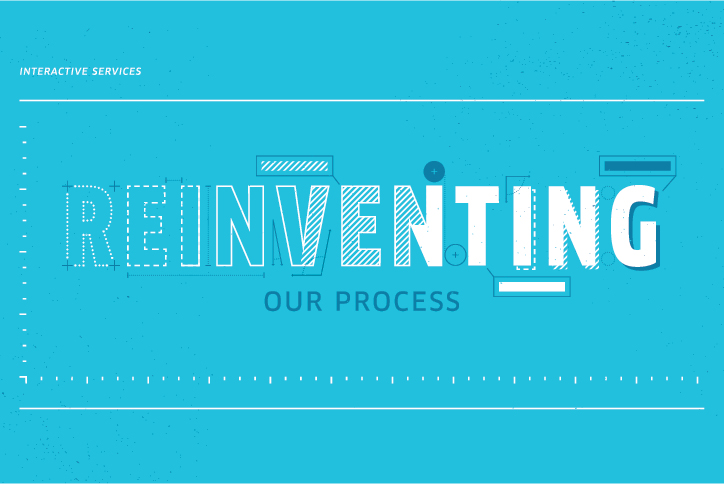Why We’re Reinventing How We Design and Build Stuff

Nebo turned 15 this year. We’ve been very lucky. We’ve grown every year. We’ve never laid a single employee off. We’ve won a ton of awards. We’ve worked with some amazing clients, we’ve been a part of some exciting campaigns, and we’ve worked side by side with some of the most talented people in the industry who we call teammates.
However, success can have its downsides. Success can cause us to focus on what has worked and what is working, at the expense of what will work in the future. When you simply say “Don’t fix what isn’t broken,” innovation stops. Blind spots form and lead to sacred cows.
That’s why we believe in attacking our own work. We’re constantly critiquing, deconstructing and rethinking our own products, services, processes and methods to make them better. Over the years we’ve dramatically changed processes, restructured departments and even reinvented entire service lines (like PR, CRO and Social Media Marketing).
But reinventing the interactive collection of services is a different beast. It’s more than attacking a single department — it’s slaying a den of dragons. UX, Design, Content and Engineering are all intricately connected. You can’t change one without affecting the rest. That’s why in the past, we’ve taken relatively smaller steps, evaluating projects in post-mortems or revising process issues as they arise.
But this year, we’re taking a big leap. We’re completely reinventing our interactive services from the ground up.
This decision is a risk — and an uncomfortable one. Our services are great, and our clients are generally happy. I’d put our creative, UX and development capabilities against any agency.
In short, we’re good at what we do. But we want to be even better.
The world is changing. Consumer expectations are changing, the buyer journey is changing, and the dot-com era is coming to an end. The digital and traditional worlds have merged into an omni-channel, always-connected world where the distinction of traditional versus digital or offline versus online no longer make sense.
Moreover, our industry has been building things the same way by and large for 50 years. The same processes that brought print, TV and radio to life evolved very slightly to bring digital experiences to life.
It’s an architectural mindset. We define the project. Write the brief. Create the wireframes. Write the copy. Design. Build. Launch. Celebrate and take pride in a job well done.
This is very similar to how we construct buildings. Or lay out a print piece. Or build mobile apps.
But does that even make sense in this day and age? Let’s think about it.
First, if we use that method to build a multimillion-dollar digital experience that will serve as a client’s most visible brand asset, the project will probably take at least one year. In this day and age, one year is an eternity.
Second, a digital experience — whether it’s a mobile app, website, Alexa Skill or in-store interactive display — isn’t a permanent thing. A building, when finished, is by and large finished. The same with a print piece or a TV or radio ad.
However, digital experiences are more like living, breathing things. Or at least they should be treated as such. They’re born. They grow. They mature. They age. They die. This allows us to build things much more in the spirit of their actual essence.
If we take this approach, we’d shorten that one-year launch timeline dramatically. We’d still do all of the research and planning. We’d still have creative briefs. However, we’d think about what’s really needed, focusing on impact and benefit rather than trend or gimmicky wow factor. After all, nature isn’t big on waste. We’d start with an experience that solves the biggest problems quickly and elegantly, and then move on to expand and refine. In essence, we’d birth our baby and then nurture it throughout its life.
We wouldn’t have to choose between sub-page layout one versus sub-page two, because we’d plan to test those once the site goes live, letting the actual consumer choose the preferred experience.
We wouldn’t have a multimillion-dollar mansion that gets built and left to age and then becomes outdated. We’d have a living, breathing entity that got to market faster with a continuous improvement plan to make it a better experience for customers each and every day.
This isn’t just about the desire to build things faster or with an iterative improvement plan that matches the lifecycle of what’s been built.
It’s ultimately about creating the most valuable experiences for people. We say we’re a human-centered agency built for the digital age. And those words mean very specific things to us.
It’s our mission to build amazing brand experiences for our clients so that their customers are empowered and, in some way, their lives are improved.
We will be radically customer-centric. We will take our human-centered ethos and push on the proverbial gas pedal even harder and faster. We will challenge all of our conventions and processes, as we’re clearly in a consumer-empowered world now.
We owe it to consumers to create experiences that they find valuable. Non-marketer humans don’t make distinctions between traditional or digital brand experiences. They don’t make distinctions between earned, owned or paid media. They don’t make distinctions between your site, mobile app, TV ads or interactive displays.
To the consumer, it’s just the brand experience.
Our job is to bring brands and consumers together in meaningful and authentic ways. We need to understand that time and attention are our most scarce resources and that we need to earn the right to be brought into someone’s mental universe.
In summary, we believe that our interactive approach works. It got us here. But, it won’t get us to where we want to go. It won’t get us to where we need to go to ensure that we’re building incredible customer experiences with unparalleled UX.
We’ve discussed and broken down that process, and found areas for improvement internally, and with the industry in general. From the way we conduct sales, to how project managers interact with project teams, to the way that internal reviews of work are conducted, to when we start engineering and development — it all needs to change and improve to bring us into this new world.
The next step is the hardest, and we’ll be documenting it along the way. The next step is to challenge our approach and processes. We need to build things that make us uncomfortable because they are future-forward. We’ll fail at these more than we’re used to, and we’ll need to get over that. We will also need to knock down those internal sacred cows that are outdated or likely won’t stand the test of time.
In essence, we will reinvent how we design and build things while we’re designing and building things. It’s exciting. With nearly 25 billion IoT devices, the emerging realms of AR/VR and voice technology, the expansion of user interfaces and more, the possibilities are endless.
To do this, we’re going to start off with a thought experiment. We’re getting two teams across multiple departments with various experience levels and asking them to approach a predefined project as if we were a brand new agency with no constraints.
From there, we’ll take these learnings and merge them into a new, testable process. We’ll build a pilot project to see how all our changes, assumptions and new approaches work in a real situation.
Once we successfully finish the pilot and compile and implement the learnings from it, we’ll begin to roll out these revolutionary ideas across the board, as the new foundation of our interactive process.
This will be hard. There will be bumps in the road. We’ll make a lot of mistakes. But we’ll learn and grow. We’ll get better.
We’re ready to challenge many of the things we do best. And we’re ready to help clients navigate the evolving buyer journey and infinite brand experiences.
What an exciting time to be an agency. What an exciting time to be alive. Stay tuned.

Comments
Add A Comment